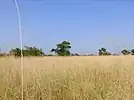 "Lucy", a 3.2-million-year-old Australopithecus afarensis fossil discovered in Hadar, Ethiopia | |
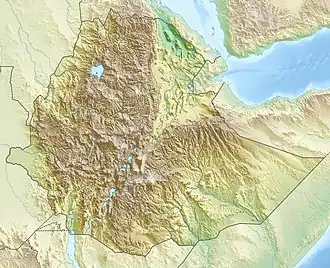 Site location in Ethiopia | |
| Location | Mille district, Afar Region, |
|---|---|
| Region | Eastern Africa |
| Coordinates | 11°10′01″N 40°37′59″E / 11.167°N 40.633°E |
| Type | Archaeological Paleontology |
| History | |
| Periods | Middle - Late Pliocene |
| Site notes | |
| Excavation dates | 1970, 1972, 1973, 1974, 2000 |
| Archaeologists | Donald Johanson Maurice Taieb Denis Geraads Zeresenay Alemseged |
| Condition | Excavated |
| Ownership | Ethiopian Government |
Hadar or Hadar Formation (also spelled Qad daqar, Qadaqar; Afar "white [qidi] stream [daqar]")[1] is a paleontological fossil site located in Mille district, Administrative Zone 1 of the Afar Region, Ethiopia, 15 km upstream (west) of the A1 road's bridge across the Awash River (Adayitu kebele).[2]
It is situated on the southern edge of the Afar Triangle (part of East Africa's Great Rift Valley), along the left banks of the Awash River, between two minor tributaries, the eponymous Kada Hadar and the Kada Gona.[2] In 1972, Taieb organized a small exploratory reconnaissance of the Afar region to investigate more paleontological finds there. After six weeks of exploration, the party focused on the Hadar site.[3]
The site has yielded some of the most well-known hominin fossils, including "Lucy". These hominin fossils range in age from approximately 3.42 to 2.90 million years ago. These finds give us a greater understanding of hominin evolution during this period.
It is postulated that the specimens in the region were deposited by way of a large river system with associated crevasse channels/splays, deltas, and distributary channels, as well as periodic transgressions of paleolake Hadar located east of the research area (Aronson and Taieb, 1981, Tiercelin, 1986, Campisano and Feibel, in press) possibly related to geological activity or climatic cycles in at least the Kada Hadar Member (Yemane et al., 1996, Yemane, 1997, Campisano and Feibel, in press)."
According to Jon Kalb, early maps show caravan routes passing within 10 to 15 km of Hadar but not through it. The British explorer L.M. Nesbitt passed 15 km west of Hadar in 1928.[1]
Geology
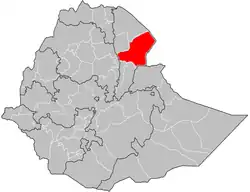
The region's rocks consist mainly of mudstones, siltstones, fine-grained sandstones and volcanic tuffs. The region of Hadar has been divided into four geologic members — Basal (~3.8–3.42 Ma), Sidi Hakoma (~3.42–3.26 Ma), Denen Dora (~3.26–3.2 Ma), and Kada Hadar (<~3.2 Ma)—with three tuffs (Sidi Hakoma Tuff [SHT], Triple Tuff [TT] and Kada Hadar Tuff [KHT]) separating the four members.
The Sidi Hakoma member tends towards high rainfall and low seasonality. The overlying Denan Dora Member was a grassland habitat. Finally, the Kada Hadar Member was an even more open and arid habitat, as seen in the high abundance of antilopines, which frequent these types of terrains.[3]
Paleontology
The first paleo-geological explorations of the Hadar area were conducted by Maurice Taieb. He found Hadar in December 1970 by following the Ledi River, which originates in the highlands north of Bati to empty into the Awash River. Taieb recovered several fossils in the area and led a party back to Hadar in May 1972. In October 1973, 16 individuals with the International Afar Research Expedition (IARE) arrived at Hadar and camped there for two months during which the first hominin fossil was found. (Taieb claims in his 1985 book Sur la Terre des premiers Hommes to have discovered the Hadar fields in 1968, but Kalb argues that claim to be incorrect.)[4] The IARE party examined a series of sedimentary layers called the Hadar Formation, which was dated to the late Pliocene to early Pleistocene epochs (3.5 to 2.3 million years ago).[5]
Discovery of Lucy
The anthropologist Donald Johanson, a member of the 1973 expedition to Hadar, returned the next year and discovered the fossil hominin "Lucy" in the late fall of 1974.[6] He spotted a right proximal ulna in a gully, followed by an occipital bone, a femur, some ribs, a pelvis, and a lower jaw. Within two weeks, nearly 40% of the hominoid skeleton had been identified and cataloged.[7] Lucy is the most famous fossil to have been found at Hadar. Lucy is among the oldest hominin fossils ever discovered[6] and was later given the taxonomic classification Australopithecus afarensis. (The name 'Lucy' was inspired by the song "Lucy in the Sky with Diamonds" by The Beatles, which happened to be playing on the radio at base camp.)
Specimens and inferences
In 1975, Donald Johanson made another discovery at a nearby site in Hadar: 216 specimens from approximately 17 individuals, most likely related and varying in age, called AL 333 (colloquially referred to as the "First Family").
About thirty years later in nearby Dikika, another Australopithecus afarensis fossil skeleton was found in a separate outcrop of the Hadar Formation across the Awash River from Hadar. The skeleton is of a three-year-old girl later named "Selam," which means peace in Amharic Ethiopian languages.
In 1973 and 1974 when the first anatomical discoveries were made, their size and shape pointed towards a variety of taxa, but further research has confirmed that only one hominin taxon is present here. The first find there was a fossil knee joint estimated to date from 3.4 million years ago. Since then, the Hadar research area has yielded 370 specimens of A. afarensis, one specimen of Homo, and 7571 additional vertebrate specimens.
The specimens recovered display a variety of different primitive cranial post features, which indicate A. afarensis is distinct from other species of Australopithecus: small cranial capacity, palate similar to African apes (parallel tooth rows, shallow, long from front to back, narrow from side to side), primitive occipital, basal cranium anatomy, high frequency of unicuspid third premolars, prognathic face, and primitive mandibular anatomy. Postcranially, the pelvis, knee, ankle, and foot indicate habitual, terrestrial bipedalism, but ape-like curved finger and foot bones are retained ancestral ape-like features.[3]
Paleofauna
Other specimens discovered from the Hadar Formation contain a vast diversity of bovid species found in Africa. The bovids found in the formation included the Aepycerotini (Aepyceros), Alcelaphini (Damalborea and Parmularius), Antilopini (Gazella), Bovini (Ugandax and Pelorovis[?]), Caprini (Budorcas), Cephalophini, Hippotragini (Oryx), Neotragini (Raphicerus[?] and Madoqua), Reduncini (Kobus), and Tragelaphini (Tragelaphus).[8][9][10] Artiodactyls outside the bovid family were present within the formation as well, namely the giraffids (Giraffa and Sivatherium), Hippopotamidae (Hippopotamus), and suids (Kolpochoerus, Notochoerus, and Nyanzachoerus).[11] While a definitive list of carnivorans found within the Hadar Formation has yet to be compiled, confirmed genera that were found within the Hadar Formation include canids (Canis and Nyctereutes), felids (Dinofelis,[12] Leptailurus, Felis, Homotherium, and Panthera), hyaenids (Chasmaporthetes, Ikelohyaena, Crocuta, Hyaena, and cf. Pliocrocuta),[13] herpestids (Herpestes and cf. Helogale), mustelids (Mellivora, Enhydriodon,[14] and cf. Poecilogale), and the viverrid (cf. Civettictis). Mammals within the formation outside the artiodactyl and carnivoran families include a bat (indeterminate), the leporid (Lepus), the equid (Eurygnathohippus),[15] rhinoceroses (Ceratotherium and Diceros),[16] old world primates (Parapapio, Theropithecus, and Cercopithecoides), proboscideans (the deinothere Deinotherium and elephants Elephas, Loxodonta, and Mammuthus) [17][18][19] old world porcupines (Hystrix and Xenohystrix),[20] murid rodents (Gerbilliscus, Acomys, Golunda, Oenomys, Praomys, Saidomys, Millardia, and Mus),[21] the spalacid Tachyoryctes, a squirrel indet., and an aardvark species. Taxons within other classes are present within the Hadar Formation as well, such as birds (Plectropterus, Balearica, Anhinga, and Struthio) and reptiles (Crocodylus, Python, Varanus, and Bitis).[22][23][24][25][26][27][28][29]
Color key
|
Notes Uncertain or tentative taxa are in small text; |
Mammals
Artiodactyls
- Bovidae
| Bovids of the Hadar Formation | |||||
|---|---|---|---|---|---|
| Taxa | Species | Presence | Material | Notes | Images |
| Aepyceros | A. datoadeni | Kada Hadar Member at Hadar | Near-complete skull lacking parts of horn cores (AL 787-1 KH1)[9] | An impala | |
| Beatragus | B. sp. | Detached braincase with two horn cores[9] | A hirola | ||
| Budorcas | B. churcheri[30] | Sida Hakoma Member.[9] | Complete skull with horns (AL 136-5 DD2)[9] | An extinct takin | |
| Damalops | D. sidihakomai[31] | Sidi Hakoma Member | AL 208–7, a skull with horn cores, right P4–M3, and left M2–3. | An extinct genus of Alcelaphinae | |
| Damalborea | D. elisabethae | Basal and Sidi Hakoma members[9] | A skull with horn cores (AL 208-07 SH3)[9] | An extinct genus of Alcelaphinae | |
| D. grayi | Denen Dora and Kada Hadar members[9] | Multiple postcranial fragments, such as horn cores, maxillae, and mandibles[9] | |||
| Gazella | G. harmonae | Kada Hadar Member at Hadar[9] | Skull remains, such as isolated teeth, maxillae, frontlets, and occipital bones (AL 444-16)[9] | Extinct relatives of modern gazelles | |
| G. cf. janenschi | Denen Dora Member | Horn cores (AL 302-6 DD)[9] | |||
| G. cf. praethomsoni | Denen Dora and Kada Hadar members | Few Horn core specimens[9] | |||
| Hippotragini | Praedamalis deturi | Kada Hadar, Sida Hakoma, and Denen Dora members at Hadar | Multiple specimens based on horn cores and lower teeth[9] | Ancestor of modern oryx | |
| Kobus | K. hadarensis | Sidi Hakoma, Kada Hadar and Denen Dora member | Extinct relatives of antelopes | ||
| K. oricornus | Denen Dora and Kada Hadar members | Several specimens of braincase and horn core[9] | |||
| Madoqua | M. sp. | ||||
| Raphicerus | R. sp. | Kada Hadar and Sidi Hakoma members | Mandibles and horn cores[9] | ||
| Parmularius | P. pachyceras | Sidi Hakoma and Kada Hadar members[9] | Braincases and horn cores[9] | Large extinct alcelphines related to topis and hartebeests | |
| Pelorovis | P. sp. | ||||
| Tragelaphus | T. lockwoodi | Basal and Sidi Hakoma members | Braincase with complete horn cores (AL 142-3 SH2)[9] | Extinct relatives of spiral-horned antelopes | |
| T. rastafari | Basal, Sidi Hakoma, Denen Dora, and Kada Hadar members | Several horn core specimens | |||
| Ugandax | U. coryndonae | Denen Dora and Sidi Hakoma members at Hadar | Complete partial skull and horns (AL 194-1 DD1)[9] | Ancestor of Cape buffalo | 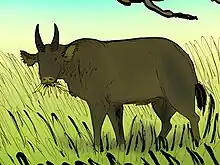 |
- Giraffidae
| Giraffids of the Hadar Formation | |||||
|---|---|---|---|---|---|
| Taxa | Species | Presence | Material | Notes | Images |
| Giraffa | G. jumae | Sidi Hakoma and Denen Dora members |
Partial teeth, vertebrae, ossicones, limb bones, and mandibles[24] | Extinct relatives of modern giraffe | |
| G. stillei | Sidi Hakoma and Denen Dora members |
Partial teeth, ossicones, limb bones, and mandibles[24] | |||
| Sivatherium | S. maurusium | Denen Dora, Kada Hadar, and Sidi Hakoma members | Partial mandibles and horns[24] | Okapi-like giraffid | |
- Hippopotamidae
| Hippopotamids of the Hadar Formation | |||||
|---|---|---|---|---|---|
| Taxa | Species | Presence | Material | Notes | Images |
| Hexaprotodon | H. protoamphibius | Denen Dora Member | Partial skull and teeth | Extinct relatives of modern pygmy hippo | |
| H. coryndoni | Sidi Hakoma Member[28] | Partial skull and teeth | |||
| Hippopotamus | H. afarensis | Basal, Sidi Hakoma, Kada Hadar, and Denen Dora members[28] | Complete postcranial skull and mandibles | Extinct subspecies related to common hippopotamus, formally named Trilobophorus afarensis | |
- Suidae
| Suids of the Hadar Formation | |||||
|---|---|---|---|---|---|
| Taxa | Species | Presence | Material | Notes | Images |
| Kolpochoerus | K. afarensis | Kada Hadar, Sidi Hakoma, and Denen Dora members[11] | Postcranial skulls, teeth fragments, and mandibles | Extinct relative of the pig family |  |
| Notochoerus | N. eulius | Kada Hadar, Lower and Upper Sidi Hakoma, and Denen Dora members[11] | Postcranial skull, teeth, and mandibles | A Tetraconodontinae pig. | |
| Nyanzachoerus | N. kanamensis | Basal and Sidi Hakoma members[28] | Complete cranium, mandibles, and dentition | A Tetraconodontinae pig. | |
| N. pattersoni | Basal, Lower and Upper Sidi Hakoma, and Denen Dora members[11] | Complete skulls, mandibles, and dentition[11] | |||
Carnivorans
- Canidae
| Canids of the Hadar Formation | |||||
|---|---|---|---|---|---|
| Taxa | Species | Presence | Material | Notes | Images |
| Nyctereutes | N. lockwoodi | Sidi Hakoma and Denen Dora members at Dikika[23] | Nearly complete skull (DIK-31-1)[32] | A raccoon dog | |
- Felidae
| Felids of the Hadar Formation | |||||
|---|---|---|---|---|---|
| Taxa | Species | Presence | Material | Notes | Images |
| Dinofelis | D. aronoki | Kada Hadar Member[12] | Postcranial member: distal radius (AL-363-20)[12] | Sabertooth cats |  |
| D. petteri | Sidi Hakoma and Denen Dora members[12] | Postcranial member: partial humerus (AL 168-30), proximal ulna (AL 262-9), and right astragalus (Al 173-11)[12] | |||
| Felis | F. sp. | ||||
| Homotherium | H. hadarensis | Denen Dora Member[23] | Complete cranium skull, mandible fragments (DIK-96-1), teeth, and forelimbs[23] | A sabertooth cat | |
| Megantereon | M. sp. | ||||
| Leptailurus | L. sp. | ||||
| Panthera | P. sp. | ||||
- Herpestidae
| Herpestids of the Hadar Formation | |||||
|---|---|---|---|---|---|
| Taxa | Species | Presence | Material | Notes | Images |
| Herpestes | H. sp. | Dikika site | Tooth fragments | A mongoose | |
- Hyaenidae
| Hyaenids of the Hadar Formation | |||||
|---|---|---|---|---|---|
| Taxa | Species | Presence | Material | Notes | Images |
| Chasmaporthetes | C. sp. | Sidi Hakoma and Denen Dora members at Hadar[13] | Hunting hyena | ||
| Crocuta | C. dietrichi | Sidi Dakoma , Denen Dora, and Basal members at Hadar[13] | Fragmented mandibles (DIK-32-1)[23][13] | Extinct relatives of modern hyena | |
| C. eturono | Kada Hadar Member | Partial maxilla (DIK-73-1)[23] | |||
| Hyaena | H. sp. | ||||
| Ikelohyaena | I. abronia | Sidi Hakoma Member at Hadar[13] | Early member of the Parahyaena lineage and the earliest close relative of the modern striped hyena | ||
| Pliocrocuta | P. cf. perierri | Sidi Hakoma and Denen Dora members | |||
- Mustelidae
| Mustelids of the Hadar Formation | |||||
|---|---|---|---|---|---|
| Taxa | Species | Presence | Material | Notes | Images |
| Enhydriodon | E. dikikae | Basal and Sidi Hakoma members at Dikika[14][23] | Partial skull (DIK-56-9) and humerus (DIK-78-1)[14][23] | Extinct giant river otter | |
| Lutra | L. hearsti | Lower part of Sidi Hakoma Member at Dikika | Upper teeth fragments (DIK-50–35)[23] | Extinct relative of otters | |
| Mellivora | M. sp. | ||||
| Poecilogale | P. sp. | ||||
- Viverridae
| Viverrids of the Hadar Formation | |||||
|---|---|---|---|---|---|
| Taxa | Species | Presence | Material | Notes | Images |
| Civettictis | C. sp. | A civet | |||
Proboscideans
- Deinotheriidae
| Deinotheriids of the Hadar Formation | |||||
|---|---|---|---|---|---|
| Taxa | Species | Presence | Material | Notes | Images |
| Deinotherium | D. bozasi | Denen Dora, Kada Hadar, and Sidi Hakoma members | Complete cranium skull and teeth fragments | A large extinct elephant-like proboscidean | 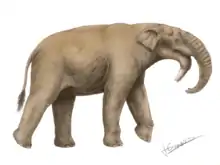 |
- Elephantidae
| Elephantids of the Hadar Formation | |||||
|---|---|---|---|---|---|
| Taxa | Species | Presence | Material | Notes | Images |
| Elephas | E. ekorensis | Sidi Hakoma and Denen Dora members at Hadar and Dikika[18] | Mandibles and molar fragments | Extinct lineage related to Asian elephant | |
| Loxodonta | L. adaurora | Denen Dora and Sidi Hakoma members at Hadar[17] | Mandibles and molar fragments | Extinct subspecies of modern African elephant | |
| L. exoptata | Denen Dora Member | Undescribed molars[17] | |||
| Mammuthus | M. sp. | Sidi Hakoma and Denen Dora Member. | Undescribed molars[17] | A mammoth relative | |
| Palaeoloxodon recki | P. r. brumpti | Sidi Hakoma Member[18] | Mandibles and molar fragments | Extinct relative of African elephant | 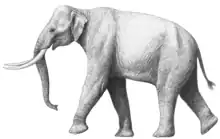 |
Perissodactyls
- Equidae
| Equids of the Hadar Formation | |||||
|---|---|---|---|---|---|
| Taxa | Species | Presence | Material | Notes | Images |
| Eurygnathohippus | E. afarense | Kada Hadar Member | Partial skull (AL 363-18) and mandibles[15] | Extinct relatives of hipparionine horse | |
| E. hasumense | Denen Dora Member | Partial skull (AL 340-8) and mandibles[15] | |||
- Rhinocerotidae
| Rhinocerotids of the Hadar Formation | |||||
|---|---|---|---|---|---|
| Taxa | Species | Presence | Material | Notes | Images |
| Ceratotherium | C. mauritanicum | Sidi Hakoma Member at Lower Awash of Dikika | Complete cranium skull (AL-129-25)[16] | Ancestor of modern white rhinoceros | |
| Diceros | D. praecox | Sidi Hakoma Member at Lower Awash of Dikika | Incomplete cranium skull fragments and jawbones[16] | Direct ancestor of modern black rhinoceros, formally named Ceratotherium praecox | |
Primates
- Cercopithecidae
| Cercopithecids of the Hadar Formation | |||||
|---|---|---|---|---|---|
| Taxa | Species | Presence | Material | Notes | Images |
| Cercopithecoides | C. meaveae | Sidi Hakoma Member | Partial skeleton (A.L. 2-64 and A.L. 222-14)[25] | A colobine monkey | |
| Rhinocolobus | R. turkanaensis | Sidi Hakoma and Denen Dora members | Preserved mandibles and teeth fragments[25] | Extinct relative of colobus monkey | |
| Parapapio | P. cf. jonesi | Sidi Hakoma and Kada Hadar members | Complete postcranial skull, partial limbs, teeth fragments, and mandibles[25] | A prehistoric baboon | |
| Theropithecus oswaldi[33] | T. o. darti | Basal, Denen Dora, Kada Hadar, and Sidi Hakoma members | Postcranial skulls differentiated between male and female[25] | Extinct relatives of gelada baboons | |
| T. o. ecki | Denen Dora Member | Female cranium skull and mandible | |||
| T. o. oswaldi | Sidi Hakoma and Kada Hadar members | Postcranial skulls differentiated between male and female[25] | |||
- Hominidae
| Hominids of the Hadar Formation | |||||
|---|---|---|---|---|---|
| Taxa | Species | Presence | Material | Notes | Images |
| Australopithecus | A. afarensis | Basal, Denen Dora, Kada Hadar, and Sidi Hakoma members | Partial skeletons featuring small cranial capacity, primitive occipitals, basal cranium anatomy, high frequency of unicuspid third premolars, prognathic faces, and primitive mandibular anatomy | An australopithecine hominid | 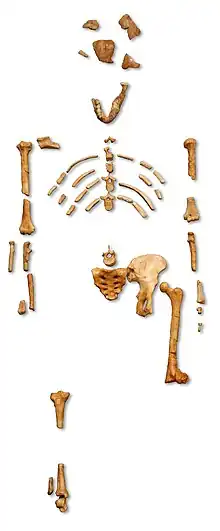  AL 444-2 skull |
Rodents
| Rodents of the Hadar Formation | |||||
|---|---|---|---|---|---|
| Taxa | Species | Presence | Material | Notes | Images |
| Acomys | A. cf. lavocati | Mandible specimens[21] | Spiny mice | ||
| A. cf. lemniscomys | Right mandible and broken tooth root[21] | ||||
| Gerbilliscus | G. sp. | Right maxillary fragment with M2-3 and right mandible fragment with M1-3[21] | Relative of gerbil species | ||
| Golunda | G. gurai | Murine rodent closely related to the Indian bush rat | |||
| Hystrix | H. cf. makapanensis | Sidi Hakoma Member[20] | An Old World porcupine | ||
| Mastomys | M. cf. minor | Partial skull and mandibles[21] | Extinct relative of the multimammate mouse | ||
| Millardia | M. coppensi | Extinct relatives of soft-furred rat | |||
| M. taiebi | |||||
| Mus | M. indet. | Unknown relative of Murini | |||
| Oenomys | O. tiercelini | Extinct relative of modern rusty-nosed rat | |||
| Pelomys | P. cf dietrichi | Mandibles | A groove-toothed swamp rat | ||
| Praomys | P. sp. | Sidi Hakoma Member | A.L. 894-35993, a right mandible with M1-3[21] | A Muridae species | |
| Saidomys | S. afarensis | Sidi Hakoma Member | Extinct relative of a muroid mouse | ||
| Tatera | T. sp. | Sidi Hakoma and Denen Dora members | Extinct relative of the Indian gerbil | ||
| Thallomys | T. cf. quadrilobatus | Complete skull with both mandibles[21] | Extinct relative of the rat family endemic to Africa | ||
| Thryonomys | T. swinderianus | A cane rat | |||
| Xenohystrix | X. cf. crassidens | Sidi Hakoma and Denen Dora members | An old-world porcupine | ||
| Xerus | X. sp. | Kada Hadar Member | An unstriped ground squirrel | ||
Birds
| Birds of the Hadar Formation | |||||
|---|---|---|---|---|---|
| Taxa | Species | Presence | Material | Notes | Images |
| Anhinga | A. hadarensis[34] | An extinct darter | |||
| Balearica | B. sp. | ||||
| Plectropterus | P. sp. | ||||
| Struthio | S. sp. | ||||
Reptiles
| Reptiles of the Hadar Formation | |||||
|---|---|---|---|---|---|
| Taxa | Species | Presence | Material | Notes | Images |
| Bitis | B. sp. | ||||
| Crocodylus | C. sp. | ||||
| Python | P. sp. | ||||
| Varanus | V. sp. | ||||
See also
References
- 1 2 Jon Kalb Adventures in the Bone Trade (New York: Copernicus Books, 2001), p. 83
- 1 2 E. N. Dimaggio et al., "Tephrostratigraphy and depositional environment of young (<2.94 Ma) Hadar Formation deposits at Ledi-Geraru, Afar, Ethiopia", Journal of African Earth Sciences 112A (December 2015), pp. 234–250 (Figure 2), doi:10.1016/j.jafrearsci.2015.09.018.
- 1 2 3 Johanson, Donald (1 March 2017). "The paleoanthropology of Hadar, Ethiopia". Comptes Rendus Palevol. Des gènes à la culture / From genes to culture. 16 (2): 140–154. doi:10.1016/j.crpv.2016.10.005. ISSN 1631-0683.
- ↑ Halstead, L. B. (1984). A la recherche du passé: la vie sur Terre, des origines aux premiers hommes. Hachette. ISBN 2010096029. OCLC 25125386.
- ↑ Feibel, Craig S.; Christopher J. Campisano (2004). "Sedimentary Patterns in the Pliocene Hadar Formation, Afar Rift, Ethiopia".
{{cite journal}}: Cite journal requires|journal=(help) - 1 2 Hogenboom, Melissa. "The 'Lucy' fossil rewrote the story of humanity". Retrieved 25 October 2018.
- ↑ "Lucy's Story | Institute of Human Origins". iho.asu.edu. Retrieved 25 October 2018.
- ↑ Reed, Kaye & Bibi, Faysal. (2011). Fossil Tragelaphini (Artiodactyla: Bovidae) from the Late Pliocene Hadar Formation, Afar Regional State, Ethiopia. Journal of Mammalian Evolution. 18. 57-69. 10.1007/s10914-010-9146-6.
- 1 2 3 4 5 6 7 8 9 10 11 12 13 14 15 16 17 18 19 20 Geraads, D.; Bobe, R.; Reed, K. (2012). "Pliocene Bovidae (Mammalia) from the Hadar Formation of Hadar and Ledi-Geraru, Lower Awash, Ethiopia". Journal of Vertebrate Paleontology, 32(1): 180–197. http://www.jstor.org/stable/41407716
- ↑ Reed, K. E. (2008). "Paleoecological Patterns at the Hadar Hominin Site, Afar Regional State, Ethiopia". Journal of Human Evolution, 54(6): 743–768. https://doi.org/10.1016/J.JHEVOL.2007.08.013
- 1 2 3 4 5 Cooke, H.B. (1978). Pliocene-Pleistocene Suidae from Hadar, Ethiopia.
- 1 2 3 4 5 Werdelin, Lars & Lewis, Margaret. (2001). A revision of the genus Dinofelis (Mammalia, Felidae). Zoological Journal of the Linnean Society. 132. 147 - 258. 10.1111/j.1096-3642.2001.tb02465.x.
- 1 2 3 4 5 Werdelin, L., & Lewis, M. E. (2008). New Species of Crocuta from the Early Pliocene of Kenya, with an Overview of Early Pliocene Hyenas of Eastern Africa. Journal of Vertebrate Paleontology, 28(4), 1162–1170. http://www.jstor.org/stable/20491047
- 1 2 3 Geraads, Denis; Alemseged, Zeresenay; Bobe, René; Reed, Denné (2011). "Enhydriodon dikikae, sp. nov. (Carnivora: Mammalia), a gigantic otter from the Pliocene of Dikika, Lower Awash, Ethiopia". Journal of Vertebrate Paleontology. 31 (2): 447–453. doi:10.1080/02724634.2011.550356. S2CID 84797296.
- 1 2 3 Gilbert, William & Bernor, Raymond. (2009). Equidae. 10.1525/california/9780520251205.003.0006.
- 1 2 3 Geraads, D. (2005). "Pliocene Rhinocerotidae (Mammalia) from Hadar and Dikika (Lower Awash, Ethiopia), and a Revision of the Origin of Modern African Rhinos". Journal of Vertebrate Paleontology, 25(2), 451–461. http://www.jstor.org/stable/4524458
- 1 2 3 4 Kalb, J. E., Mebrate, A., & Tischler, D. (1993). Fossil Elephantoids: From the Hominid-Bearing Awash Group, Middle Awash Valley, Afar Depression, Ethiopia. Transactions of the American Philosophical Society, 83(1), i–114. https://doi.org/10.2307/1006558
- 1 2 3 Sanders, William & Haile-Selassie, Yohannes. (2011). A New Assemblage of Mid-Pliocene Proboscideans from the Woranso-Mille Area, Afar Region, Ethiopia: Taxonomic, Evolutionary, and Paleoecological Considerations. Journal of Mammalian Evolution. 19. 10.1007/s10914-011-9181-y.
- ↑ Rowan J.; Lazagabaster, I. A.; Campisano, C. J.; Bibi, F.; Bobe, R.; Boisserie, J. R.; Frost, S. R.; Getachew, T.; Gilbert, C. C.; Lewis, M. E.; Melaku, S.; Scott, E.; Souron, A.; Werdelin, L.; Kimbel, W. H.; Reed, K. E. "Early Pleistocene Large Mammals from Maka'amitalu, Hadar, Lower Awash Valley, Ethiopia". PeerJ. 2022 Apr 6;10:e13210. doi: 10.7717/peerj.13210. PMID 35411256; PMCID: PMC8994497.
- 1 2 Azzarà, B., Cherin, M., Adams, J. et al. The Thorny Issue of African Porcupines: a New Mandible of Hystrix makapanensis from Olduvai Gorge (Tanzania) and Rediagnosis of the Species. J Mammal Evol 29, 447–474 (2022). https://doi.org/10.1007/s10914-021-09588-z
- 1 2 3 4 5 6 7 REED, D. N. (2011). NEW MURID (MAMMALIA, RODENTIA) FOSSILS FROM A LATE PLIOCENE (2.4 MA) LOCALITY, HADAR A.L. 894, AFAR REGION, ETHIOPIA. Journal of Vertebrate Paleontology, 31(6), 1326–1337. http://www.jstor.org/stable/41407688
- ↑ Campisano, Christopher J.; Rowan, John; Reed, Kaye E. (2022). "Chapter 18: The Hadar Formation, Afar Regional State, Ethiopia: Geology, Fauna, and Paleoenvironmental Reconstructions". In Reynolds, Sally C.; Bobe, René (eds.). African Paleoecology and Human Evolution. Cambridge University Press. pp. 214–228. doi:10.1017/9781139696470.018.
- 1 2 3 4 5 6 7 8 9 Geraads, Denis; Alemseged, Zeresenay; Bobe, René; Reed, Denné (2015). "Pliocene Carnivora (Mammalia) from the Hadar Formation at Dikika, Lower Awash Valley, Ethiopia". Journal of African Earth Sciences. 107: 28–35. doi:10.1016/j.jafrearsci.2015.03.020.
- 1 2 3 4 Geraads, Denis; Reed, Kaye; Bobe, Rene (2013) "Pliocene Giraffidae (Mammalia) from the Hadar Formation of Hadar and Ledi-Geraru, Lower Awash, Ethiopia". Journal of Vertebrate Paleontology, 33(2): 470–481, DOI: 10.1080/02724634.2013.723657
- 1 2 3 4 5 6 Frost Stephen R.; Delson, Eric (2022). "Fossil Cercopithecidae from the Hadar Formation and Surrounding Areas of the Afar Depression, Ethiopia". Journal of Human Evolution, 43(5): 687–748, ISSN 0047-2484, https://doi.org/10.1006/jhev.2002.0603.
- ↑ White, T. D.; Moore, Roderic V.; Suwa, G. (1984). "Hadar Biostratigraphy and Hominid Evolution". Journal of Vertebrate Paleontology, 4(4), 575–583. http://www.jstor.org/stable/4523018
- ↑ Kalb, J. E.; Jolly, C. J.; Tebedge, Sleshi; Mebrate, A.; Smart, Charles; Oswald, Elizabeth B.; Whitehead, P. F.; Woods, Craig B.; Adefris, Tsrha;; Rawn-Schatzinger, Viola (1982). "Vertebrate Faunas from the Awash Group, Middle Awash Valley, Afar, Ethiopia". Journal of Vertebrate Paleontology, 2(2): 237–258. http://www.jstor.org/stable/4522897
- 1 2 3 4 Reed, K. E. (2008). Paleoecological patterns at the Hadar hominin site, Afar Regional State, Ethiopia. Journal of Human Evolution, 54(6), 743–768. https://doi.org/10.1016/J.JHEVOL.2007.08.013
- ↑ Howell, F. C., & Petter, G. (1979). Diversification et affinites des Carnivores pliocenes du groupe de l’Omo et de la formation d’Hadar (Ethiopie). Bulletin De La Societe Geologique De France. https://doi.org/10.2113/gssgfbull.s7-xxi.3.289
- ↑ Gentry, A. (1996). "A fossil Budorcas (Mammalia, Bovidae) from Africa". In Palaeoecology and Palaeoenvironments of Late Cenozoic Mammals: Tributes to the Career of C. S. (Rufus) Churcher. Toronto: University of Toronto Press. pp. 571–587. https://doi.org/10.3138/9781487574154-028
- ↑ Vrba, E. S. (1997). "New fossils of Alcelaphini and Caprinae (Bovidae, Mammalia) from Awash, Ethiopia, and Phylogenetic Analysis of Alcelaphini".
- ↑ Geraads, D.; Alemseged, Z.; Bobe, R.; Reed, D. (2010). "Nyctereutes Lockwoodi, N. Sp., a New Canid (Carnivora, Mammalia) from the Middle Pliocene OF Dikika, Lower Awash, Ethiopia". Journal of Vertebrate Paleontology 30(3), 981–987. http://www.jstor.org/stable/40666211
- ↑ Getahun, D. A.; Delson, E.; Seyoum, C. M. (2023). "A Review of Theropithecus oswaldi with the Proposal of a New Subspecies". Journal of Human Evolution 180, 103373. https://doi.org/10.1016/j.jhevol.2023.103373
- ↑ Author links open overlay panel Pierce Brodkorb *, Résumé Des restes d’anhingas ont été touvés dans les gisements à Hominidés de l’Hadar, Summary Remains of anhingas from the Early Man Sites of Hadar, BallmannP., BaumelJ.J., BedenM., Bonaparte C.L., Brodkorb P., Vis C.W., D., Hay R.L., Howell F.C., Lambrecht K., & Leakey L.S.B. (2006, March 27). Fossil Anhingas (aves: Anhingidae) from early man sites of Hadar and Omo (Ethiopia) and Olduvai Gorge (Tanzania). Geobios. https://www.sciencedirect.com/science/article/abs/pii/S0016699582800715#preview-section-cited-by
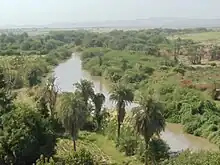
.jpg.webp)
.jpg.webp)
